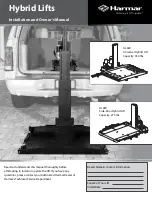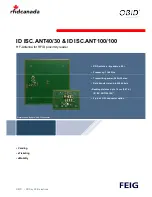
Section 3 - Operation
Battery Maintenance
WARNING
Risk of electric shock – do not immerse the
charger in water. Though the charger is highly
resistant to water, it is not designed for immersion,
and an electric shock can occur.
CAUTION
Hot Surfaces - During charging, the surface of the
charger may become hot to the touch, especially in
higher ambient temperatures. This is normal. Avoid
touching the surface of the charger.
1.
Provide adequate ventilation for the batteries and
charger.
NOTE
The convection cooled design requires access
to cooling air for proper operation. Do not allow
blankets or other materials to cover the charger.
Although the charger protects itself against
overheating, the charger cooling fins should
be cleaned if clogged with debris for best
performance.
WARNING
There could be a spark during charging. Be careful
when using fuels, solvents or other flammables
near the charger or batteries.
2.
Connect the power supply cord to a properly
grounded socket between 100 to 240 VAC, 50/60
Hz. The charger automatically senses and adjusts
to the AC input voltage range.
3.
The charging time is affected by numerous factors
including the battery Amp-Hour capacity, depth
of discharge, battery temperature, and battery
condition (new, old, or defective). Batteries larger
than 240 AH can be recharged but will take longer.
WARNING
Do not disconnect the DC output wires near the
batteries when the charger is ON. The resulting
arcing could cause the batteries to explode. If the
charger must be disconnected, first disconnect
the AC power supply cord from its outlet, then
disconnect the charger DC connections.
WARNING
Risk of an electric shock – do not touch
uninsulated parts of the charger output wires,
battery connector, or battery terminals.
WARNING
Visually and manually inspect to verify the DC
output wires and terminals are in good working
condition before each use.
4.
The charger will start automatically within four
to six seconds. The charger will start even with
severely discharged batteries (down to 1 V
terminal voltage). Once the charging starts, the
LEDs indicate the charging progress.
▪
Batteries do not fully charge:
If the batteries
are charged overnight, make sure the AC supply
is not being switched off at night with other
building items. Check the battery condition and
for dead cells or reduced capacity. Replace the
charger only if other problems are not found.
▪
The AC line circuit breaker or fuse is blown:
A
defective circuit breaker or fuse, an overloaded
circuit, or a charger problem can cause this
condition. Try connecting the charger to a
different AC outlet (on a different circuit) in
the building. If the AC supply is sufficient, the
charger should be replaced.
SJIII 4740
Page 67
Содержание SJIII 4740
Страница 1: ...198735AGA April 2018 DC ELECTRIC SCISSORS MODEL SJIII 4740 OPERATING MANUAL ANSI CSA...
Страница 12: ...Page 12 SJIII 4740 Notes...
Страница 34: ...FAMILIARIZATION FAMILIARIZATION Page 34 SJIII 4740 Notes...
Страница 68: ...Page 68 SJIII 4740 Notes...
Страница 77: ...SJIII 4740 Page 77 Notes...
Страница 78: ...Page 78 SJIII 4740 Notes...
Страница 93: ...Cancer and Reproductive Harm https www p65warnings ca gov WARNING...
Страница 94: ...www skyjack com elig lift l sninger av folk som bryr seg...
















































